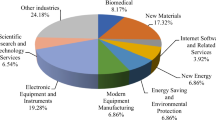Abstract
In order to support small and medium enterprises (SME) with a high degree of growth potential in technology, various kinds of technology credit guarantees are issued to companies that obtain high scores by a technology scorecard in Korea. However, their default rates are reported to be very high. The main goal of this study is to propose a new technology evaluation model that accommodates not only technology-related attributes but also environmental conditions such as firm-specific characteristics and economic situations in the manner of more objective. We then show the superior prediction ability of the proposed model to the existing one. This model also enables to apply to a stress test by considering some worst environmental situations and is expected to be used for the effective management of the various technology funds for SMEs.





Similar content being viewed by others
References
Becerra-Fernandez I, Zanakis SH and Walczak S (2002). Knowledge discovery techniques for predicting country investment risk . Comput Ind Eng 43(4): 787–800.
Berger AN and Frame WS (2005). Small business credit scoring and credit availability. Working Paper 2005–2010. Federal Reserve Bank of Atlanta.
Carling K, Jacobson T, Lindé J and Roszbach K (2007). Corporate credit risk modeling and the macroeconomy . J Bank Financ 31(3): 845–868.
Ceylan H and Ozturk HK (2004). Estimating energy demand of Turkey based on economic indicators using genetic algorithm approach . Energ Convers Mngt 45: 2525–2537.
Coldrick S, Longhurst P, Ivey P and Hannis J (2005). An R&D options selection model for investment decisions . Technovation 25: 185–193.
Credit Metrics (1997). Technical Document, from JP Morgan.
Crouhy M, Galai D and Mark R (2000). A comparative analysis of current credit risk models . J Bank Financ 24: 59–117.
CSFB (Credit Suisse First Boston) (1997). CreditRisk+, A Credit Risk Management Framework. Technical Document, from Credit Suisse Financial Products.
Duffie D, Saita L and Wang K (2007). Multi-period corporate default prediction with stochastic covariates . J Financ Econ 83(3): 635–665.
Farrukh C, Phaal C, Probert D, Gregory M and Wright J (2000). Developing a process for the relative valuation of R&D programmes . R&D Mngt 30(1): 43–53.
Gordy M (2000). A comparative anatomy of credit risk models . J Bank Financ 24: 119–149.
Henriksen AD and Traynor AJ (1999). A practical R&D project-selection scoring tool . IEEE T Eng Mngt 46(2): 158–170.
Hilbers P and Jones MT (2004). What If…?: Stress testing uses different scenarios to determine how vulnerable countries' financial systems are to shocks . Financ Dev 41(4): 24–27.
Jeon HJ and Sohn SY (2008). The risk management for technology credit guarantee fund, J Opl Res Soc 59: 1624–1639.
KNSO (2005). Korea National Statistical Office, http://www.nso.go.kr.
Lawson CP, Longhurst PJ and Ivey PC (2006). The application of a new research and development project selection model in SMEs . Technovation 26(2): 242–250.
Leonard AC and Villiers C (2000). The nature of end-user relationships in the development of electronic commerce applications. SIGCPR 2000, Chicago, IL; USA. ACM: New York.
Martino JP (2003). A review of selected recent advances in technological forecasting . Technol Forecast Soc 70: 719–733.
Moon TH and Sohn SY (2008). Technology scoring model for reflecting evaluator's perception within confidence limits . Eur J Opl Res 184(3): 981–989.
Moore JR and Baker NR (1969). An analytical approach to scoring model design-application to research and development project selection . IEEE T Eng Mngt 16(3): 90–98.
Nam JH and Jinn TH (2000). Bankruptcy prediction: Evidence from Korean listed companies during the IMF crisis . J Int Financ Mngt Account 11(3): 178–197.
Noh HJ, Roh TH and Han I (2005). Prognostic personal credit risk model considering censored information . Expert Syst Appl 28(4): 753–762.
NTTC (2005). National Technology Transfer Center, http://www.nttc.edu.
Ong CS, Huang JJ and Tzeng GH (2005). Building credit scoring models using genetic programming . Expert Syst Appl 29(1): 41–47.
Pesaran MH, Schuermann T and Weiner SM (2004). Modeling regional interdependencies using a global error-correcting macroeconometric model . J Bus Econ Stat 22(2): 129–162.
Pompe PP and Bilderbeek J (2004). The prediction of bankruptcy of small- and medium-sized industrial firms . J Bus Venturing 20(6): 847–868.
Seow HV and Thomas LC (2006). Using adaptive learning in credit scoring to estimate take-up probability distribution . Eur J Opl Res 173(3): 880–892.
Sohn SY, Moon TH and Kim SH (2005). Improved technology scoring model for credit guarantee fund . Experts Syst Appl 28(2): 327–331.
Srinivasan V and Kim YH (1987). Credit granting: A comparative analysis of classification procedures . J Financ 42: 665–683.
van Stel A, Carree M and Thurik R (2005). The effect of entrepreneurial activity on national economic growth . Small Bus Econ 24: 311–321.
van Wezel M and Potharst R (2007). Improved customer choice predictions using ensemble methods . Eur J Opl Res 181(1): 436–452.
Whittaker J, Whitehead C and Somers M (2007). A dynamic scorecard for monitoring baseline performance with application to tracking a mortgage portfolio . J Opl Res Soc 58: 911–921.
Wong PK, Ho YP and Autio E (2005). Entrepreneurship, innovation and economic growth: Evidence from GEM data . Small Bus Econ 24: 335–350.
Acknowledgements
This work was supported by the Korea Science and Engineering Foundation (KOSEF) grant funded by the Korea government (MEST) (No. R01-2008-000-11003-01).
Author information
Authors and Affiliations
Corresponding author
Rights and permissions
About this article
Cite this article
Moon, T., Sohn, S. Technology credit scoring model considering both SME characteristics and economic conditions: The Korean case. J Oper Res Soc 61, 666–675 (2010). https://doi.org/10.1057/jors.2009.7
Received:
Accepted:
Published:
Issue Date:
DOI: https://doi.org/10.1057/jors.2009.7




